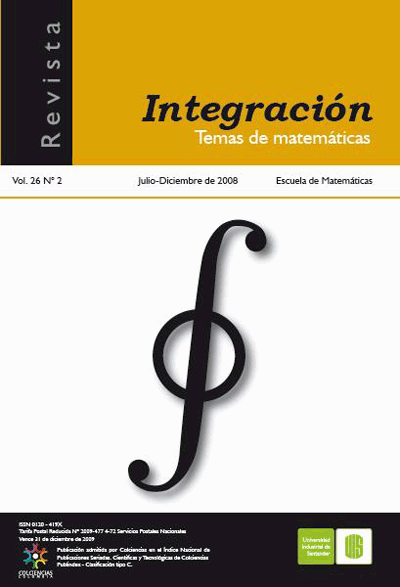Un método híbrido interfaz inmersa-conjunto de nivel para la simulación de la evolución de una biopelícula
Published 2009-03-05
Keywords
- Biopelícula,
- interfaz inmersa,
- conjunto de nivel
How to Cite
Abstract
En esta comunicación se propone un nuevo modelo para la formación de una biopelícula y se estudian los aspectos numéricos de su simulación computacional. Nuestro modelo está basado en tres aspectos fundamentales: primero, se incorpora un mecanismo de transporte de nutrientes haciala biopelícula; segundo, se incorpora un mecanismo de consumo y de crecimiento de la biopelícula; y tercero, se incorpora un mecanismo de necrosis y de decaimiento de la biopelícula. Para el modelamiento del transporte de nutrientes, hemos usado una ecuación de difusión estacionaria. Para el modelamiento del mecanismo de consumo y crecimiento, así como también del de necrosis y decaimiento, hemos modelado la biopelícula como un fluido viscoso escurriendo en un medio poroso. El aspecto clave de este modelo es que el frente de la biopelícula es una incógnita del problema, la cual depende de la solución del mismo. Así, con el fin de reconstruir el movimiento del frente, hemos usado el método del conjunto de nivel. Además, para resolver la ecuación de la presión hemos usado el así llamado método de la interfaz inmersa, el cual fue especialmente desarrollado para problemas con discontinuidades a través de una interfaz dentro de un dominio.
Downloads
References
[2] R. Dillon, L. Fauci, A. Fogelson, and D. Gaver. “Modeling biofilm processes using the immersed boundary method”, J. Computational Phys., 129 (1996), pp. 57-73.
[3] J. Dockery and I. Klapper. “Finger formation in biofilm layers”, SIAM J. Appl. Math., 62 (2001/02), pp. 853-869 (electronic).
[4] H. J. Eberl and L. Demaret. “A finite difference scheme for a degenerated diffusion equation arising in microbial ecology”, in Proceedings of the Sixth Mississippi StateUBA Conference on Diferential Equations and Computational Simulations, vol. 15 of Electron. J. Differ. Equ. Conf., San Marcos, TX, 2007, Southwest Texas State
Univ., pp. 77-96.
[5] R. J. LeVeque and Z. L. Li. “The immersed interface method for elliptic equations with discontinuous coefficients and singular sources”, SIAM J. Numer. Anal., 31 (1994), pp. 1019-1044.
[6] Z. Li and K. Ito. The immersed interface method, vol. 33 of Frontiers in Applied Mathematics, Society for Industrial and Applied Mathematics (SIAM), Philadelphia, PA, 2006. Numerical solutions of PDEs involving interfaces and irregular domains.
[7] S. Osher and R. Fedkiw. Level set methods and dynamic implicit surfaces, vol. 153 of Applied Mathematical Sciences, Springer-Verlag, New York, 2003.
[8] S. Osher and J. A. Sethian. “Fronts propagating with curvature-dependent speed: algorithms based on Hamilton-Jacobi formulations”, J. Comput. Phys., 79 (1988), pp. 12-49.
[9] C. S. Peskin. “Numerical analysis of blood flow in the heart”, J. Computational Phys., 25 (1977), pp. 220-252.
[10] J. A. Sethian. Level set methods, vol. 3 of Cambridge Monographs on Applied and Computational Mathematics, Cambridge University Press, Cambridge, 1996. Evolving interfaces in geometry, fluid mechanics, computer vision, and materials science.
[11] J. A. Sethian. Level set methods and fast marching methods, vol. 3 of Cambridge Monographs on Applied and Computational Mathematics, Cambridge University Press, Cambridge, second ed., 1999. Evolving interfaces in computational geometry, fluid mechanics, computer vision, and materials science.
[12] M. Sussman, P. Smereka, and S. Osher. “A level set approach for computing solutions to incompressible two-phase flow”, J. Comput. Phys., 114 (1994), pp. 146-159.
